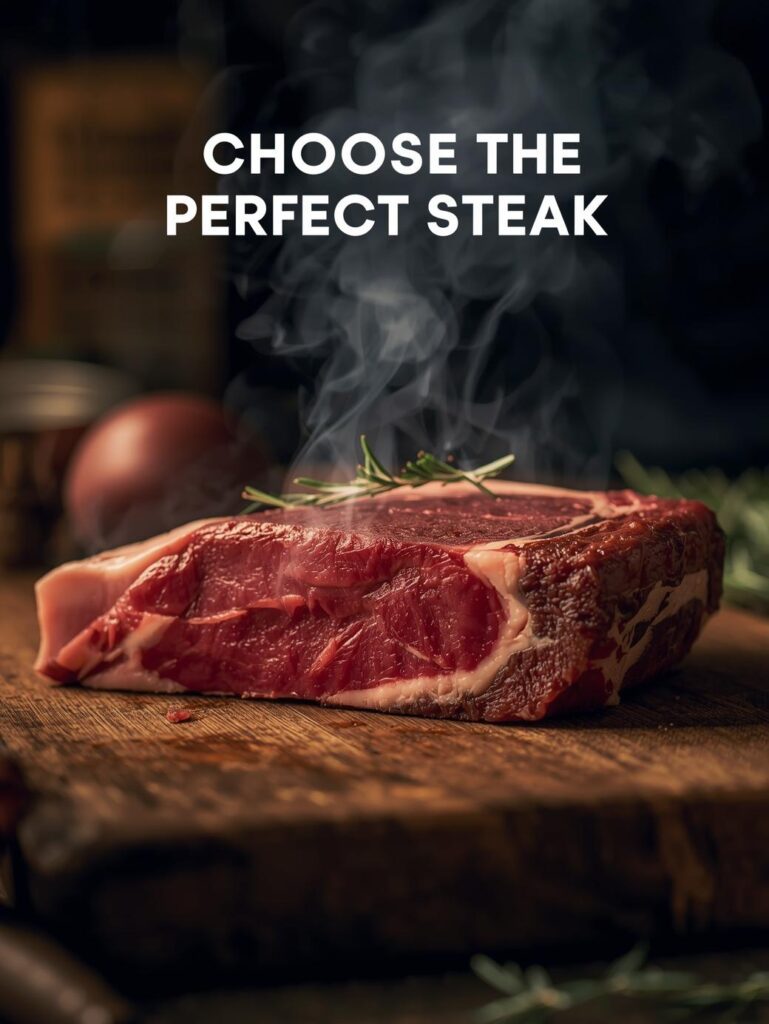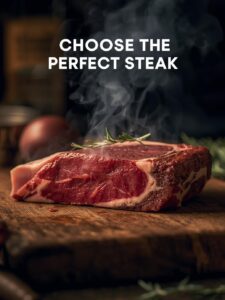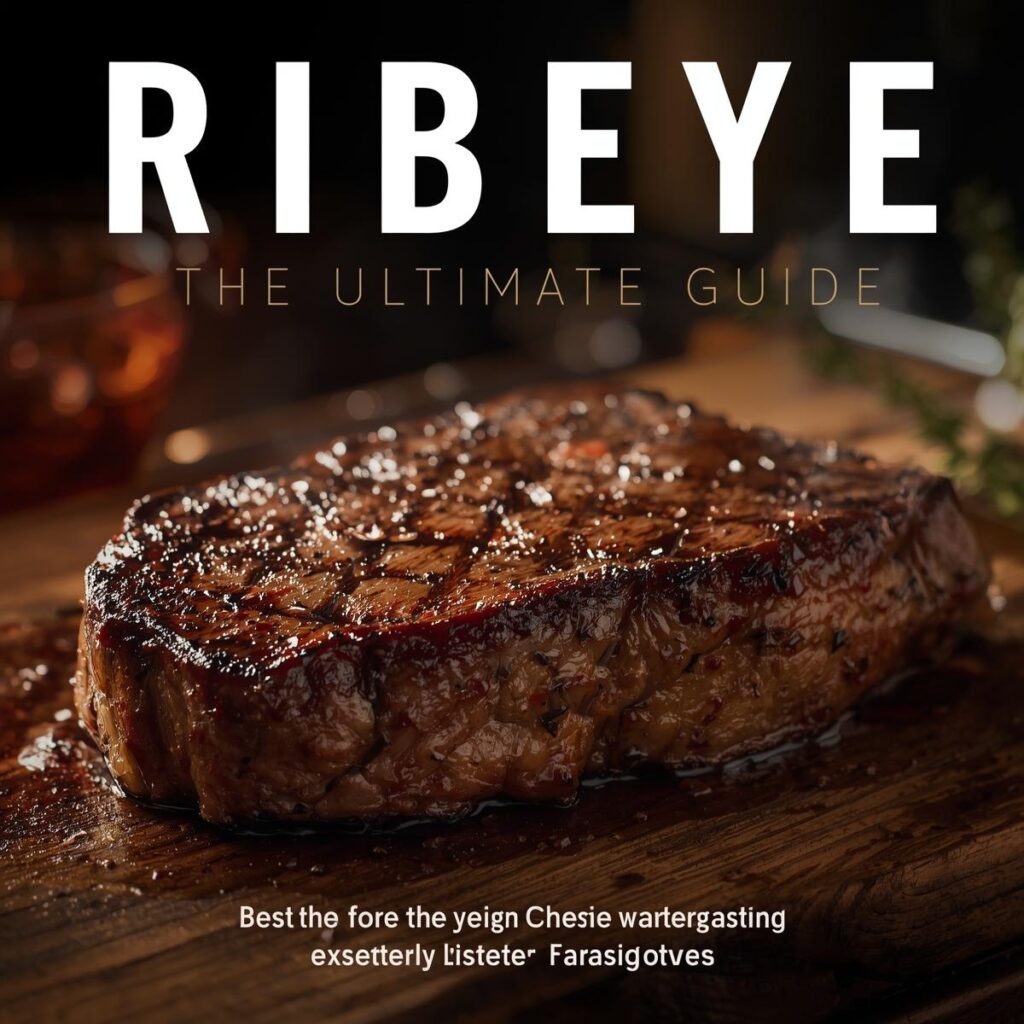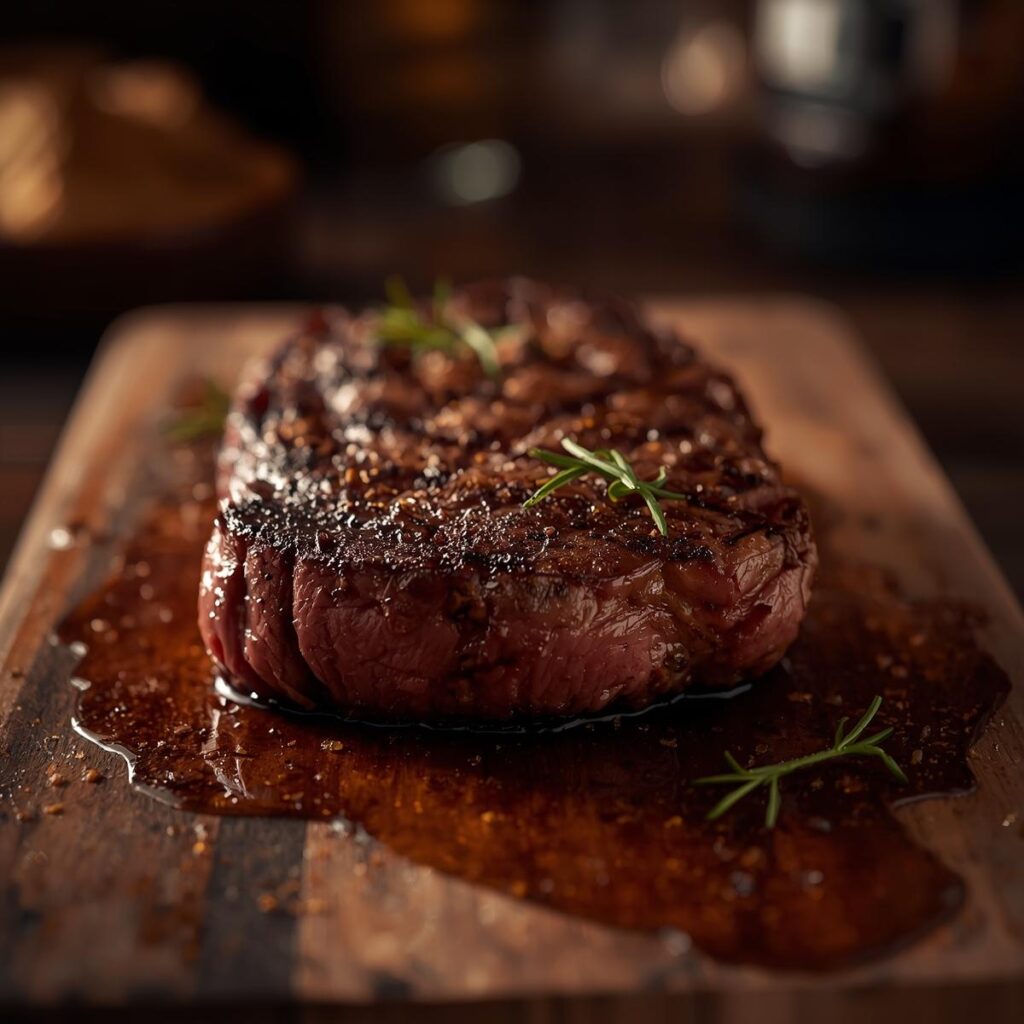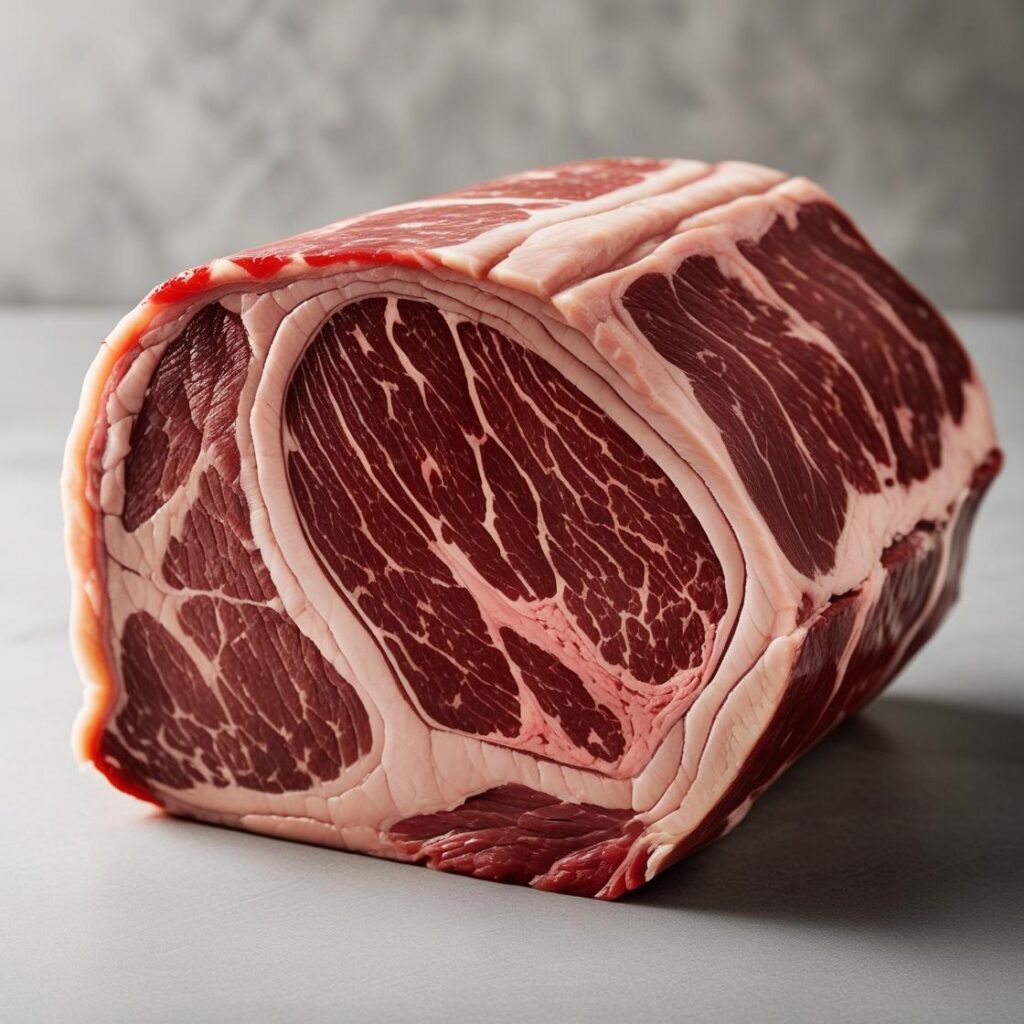Expert’s Note: This guide is your essential first step from our Ultimate Guide to Grilling Steak. A perfect cook can’t fix a poor cut. Master this selection process, and you’re already 80% of the way to a legendary steak.
HOW TO CHOOSE THE PERFECT STEAK: A BUTCHER’S GUIDE TO MARBLING, COLOR, AND THICKNESS
“Walking up to the butcher case shouldn’t feel like a guessing game. The difference between a good steak and a great one isn’t just the cooking—it’s the choosing. With three simple visual cues, you can learn to spot a winner every time, turning an overwhelming wall of red meat into a curated selection of guaranteed winners.”
How to Choose the Perfect Steak: A Butcher’s Guide to Marbling, Color, and Thickness
Download our free Steak Selection Cheat Sheet with marbling guides and thickness recommendations.
The journey to a perfect steak doesn’t start at the grill; it starts at the butcher counter. You can have the skills of a world-class pitmaster and the best equipment money can buy, but if you start with a mediocre piece of meat, you’ll end with a mediocre meal. This guide will teach you to see what butchers see—to judge a steak not by its price tag, but by the visual markers of quality and potential.
The journey to a perfect steak doesn’t start at the grill; it starts at the butcher counter. You can have the skills of a world-class pitmaster and the best equipment money can buy, but if you start with a mediocre piece of meat, you’ll end with a mediocre meal. This guide will teach you to see what butchers see—to judge a steak not by its price tag, but by the visual markers of quality and potential.
🔍 THE TRINITY OF QUALITY: MARBLING, COLOR, AND THICKNESS
These three factors are your non-negotiable checklist. Master them, and you’ll consistently bring home steaks that transform into memorable meals.
🥩 THE MARBLING MAP: READING THE FAT WITHIN
Marbling is the single most important indicator of flavor and juiciness. It refers to the fine, white streaks of intramuscular fat woven throughout the lean meat.
The Science of Marbling
Unlike the thick edge of external fat, marbling is the steak’s self-basting system. As it heats, this fat slowly melts, basting the muscle fibers from the inside out. This process creates:
- Unmatched Juiciness: The rendered fat lubricates every bite.
- Rich Flavor: Fat carries flavor compounds and creates a buttery, rich taste.
- Natural Tenderizer: The fat layers between muscle fibers make the steak easier to chew.
🎯 The Marbling Spectrum: From Select to Prime
🎯 USDA Marbling Grades (Simplified)
| Grade | Marbling Level | Best For | Value Rating |
|---|---|---|---|
| Prime | Abundant to very abundant | Special occasions, reverse searing | $$$ (Worth it for celebrations) |
| Choice | Moderate to slightly abundant | Everyday grilling, most cooking methods | $$ (The sweet spot) |
| Select | Slight to small | Marinating, budget-conscious meals | $ (Requires technique) |
Pro Tip: The “Fine Web” Test. Look for marbling that resembles a fine, connected web throughout the meat, not just large, isolated chunks of fat. This even distribution means every bite will be flavorful and juicy, not just the ones that happen to include a fat pocket.
🎨 THE COLOR CODE: WHAT YOUR STEAK’S HUE REALLY MEANS
Color tells you about the steak’s freshness and how it’s been treated. Forget the old myths—here’s what to actually look for.
✅ IDEAL: Bright Cherry-Red
This indicates fresh, well-oxygenated meat that has been properly stored. The color comes from myoglobin, a protein in muscle tissue. Bright red means it’s at its peak.
⚠️ CAUTION: Brownish or Dark Red
Not necessarily bad, but requires investigation. This can mean:
- Normal oxidation (safe if it smells fine)
- Older meat approaching its sell-by date
- Vacuum-packed meat (“bloomed” color)
Smell it—if it smells sour or off, walk away.
❌ AVOID: Gray, Green, or Rainbow Sheen
Gray indicates significant aging and spoilage. Green tints are a hard no. A rainbow or iridescent sheen is usually just light refraction on cut muscles (often on sliced roast beef), but on a fresh steak, it can indicate age or temperature abuse.
🚨 The “Wet vs. Dry” Look: Understanding Packaging
- Cryovac (Vacuum-Packed): Will appear darker, purplish-red when you open it. This is normal! The color will “bloom” to bright red after 15-30 minutes of air exposure.
- Store-Packaged (Foam Tray): Should be bright red. The absorbent pad underneath should be mostly dry or only lightly pink. A soaked pad can indicate the steak has been sitting in its own juices too long.
📏 THE THICKNESS RULE: WHY SIZE MATTERS MORE THAN WEIGHT
A steak’s thickness determines its cooking destiny. Choosing the right thickness for your intended cooking method is crucial.
🎯 The Thickness Guide: Matching Cut to Cooking Method
| Thickness | Best Cooking Method | Why It Works | Pro Tip |
|---|---|---|---|
| Thin (½” – ¾”) | Direct High Heat, Quick Sear | Cooks through before burning outside | Great for weeknights, sandwiches, salads |
| Standard (1″ – 1¼”) | Direct Heat, Sear-Finish | Balances sear and internal cooking | The all-purpose, reliable choice |
| Thick (1½” – 2″) | Reverse Sear, Two-Zone | Allows perfect internal temp with great crust | Ideal for special occasions, impressive results |
| Very Thick (2″+) | Reverse Sear, Low & Slow | Maximum control over doneness | Tomahawks, show-stopper cuts |
Why Thickness Beats Weight: Two steaks can weigh the same but have completely different thicknesses. A thicker, smaller-diameter steak will cook more evenly and give you a better crust-to-interior ratio than a thin, wide steak of the same weight.
🎯 PUTTING IT ALL TOGETHER: THE 60-SECOND STEAK EVALUATION
Here’s your rapid-fire checklist for choosing a winner every time:
The Butcher’s 5-Point Inspection
- Check the Marbling: Look for fine, web-like white streaks throughout—not just around the edges.
- Assess the Color: Bright cherry-red is ideal. Avoid brown, gray, or any off-colors.
- Measure the Thickness: Eye-ball it or ask the butcher. Match thickness to your cooking method.
- Examine the Fat Cap: Look for creamy white (not yellow) external fat, about ¼-inch thick.
- Consider the Cut: Does this cut’s personality (rich ribeye vs. beefy strip) match your craving?
🤔 FREQUENTLY ASKED QUESTIONS
Should I choose Prime or Choice grade?
Prime is fantastic for special occasions where money is no object. Choice is the sweet spot for everyday grilling—it offers great marbling at a more accessible price. A well-marbled Choice steak often outperforms a mediocre Prime one.
What about “grass-fed” vs “grain-fed”?
Grain-fed typically has more consistent marbling and a richer, buttery flavor. Grass-fed is leaner with a more mineral, “beefier” taste. It’s a matter of personal preference, but grass-fed requires more careful cooking to avoid dryness.
How important is aging?
Wet-aging (in vacuum bags) is standard and improves tenderness. Dry-aging is a premium process that concentrates flavor and creates a unique, nutty taste. For your everyday steak, don’t stress about aging—focus on the marbling, color, and thickness trinity first.
🏁 CONCLUSION: CONFIDENCE AT THE COUNTER
Choosing the perfect steak is a skill, not a mystery. By focusing on the three pillars of marbling, color, and thickness, you can walk up to any butcher counter with confidence. Remember: great marbling means flavor and juiciness, bright color means freshness, and proper thickness means cooking success.
Your next mission: Go to your local butcher or grocery store and practice this evaluation. Don’t buy anything—just look. Compare the different steaks using this checklist. Within minutes, you’ll start seeing the differences that separate the good from the great.
Master the Entire Steak Journey: Continue your education with these essential guides:

